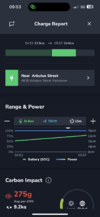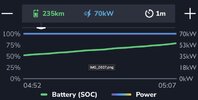Yes, that is kind of why it is strange. It's in the nature of battery charging, that they can't just blast huge high power charging into them non-stop from empty all the way to full. We refer to it as "tapering", where the power rate has to slow down as the battery gets more and more full. In a very general ballpark, the amount of time going from 0% to 80% was around the same amount of time as that top 80% to 100% when Supercharging. It will start out at 250+ kW, but after a while, that's going to have to come down to 200 and then toward 150, 100, 60, etc. So seeing a high power level of 97kW when the car is nearly to 80% seems a little unusual, except for the very newest cars.
The tapering effect is still there, but the charging power from your home connection is so low power that it's not anywhere near where that limiting would be. 7kW is hardly anything from the battery's perspective, so it wouldn't have to reduce from that 7kW until it's up around 98 or 99%. It will eventually slow down very near the end though.




